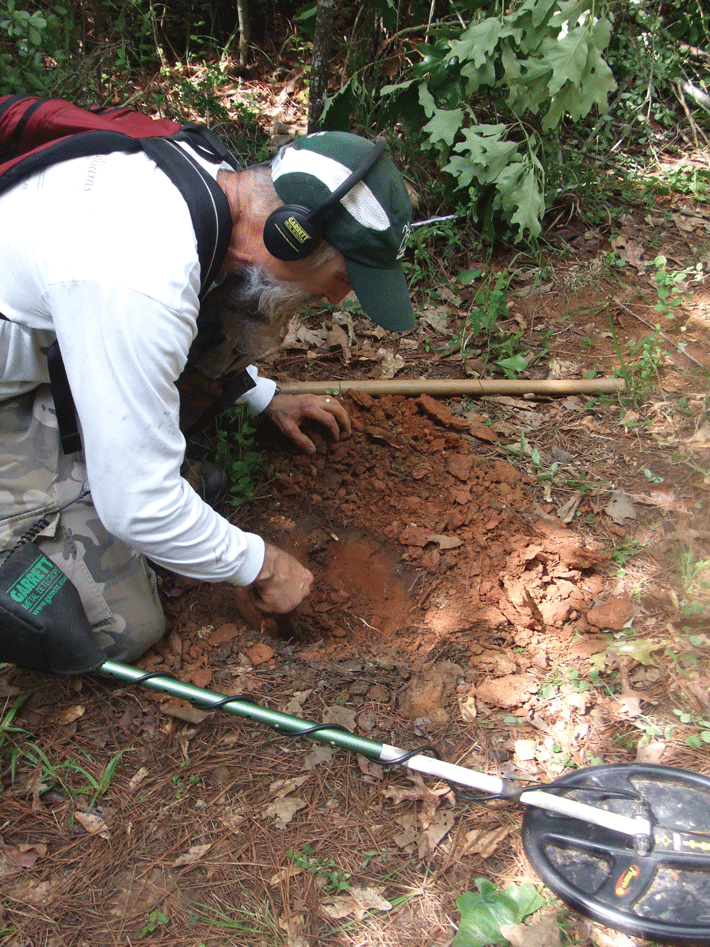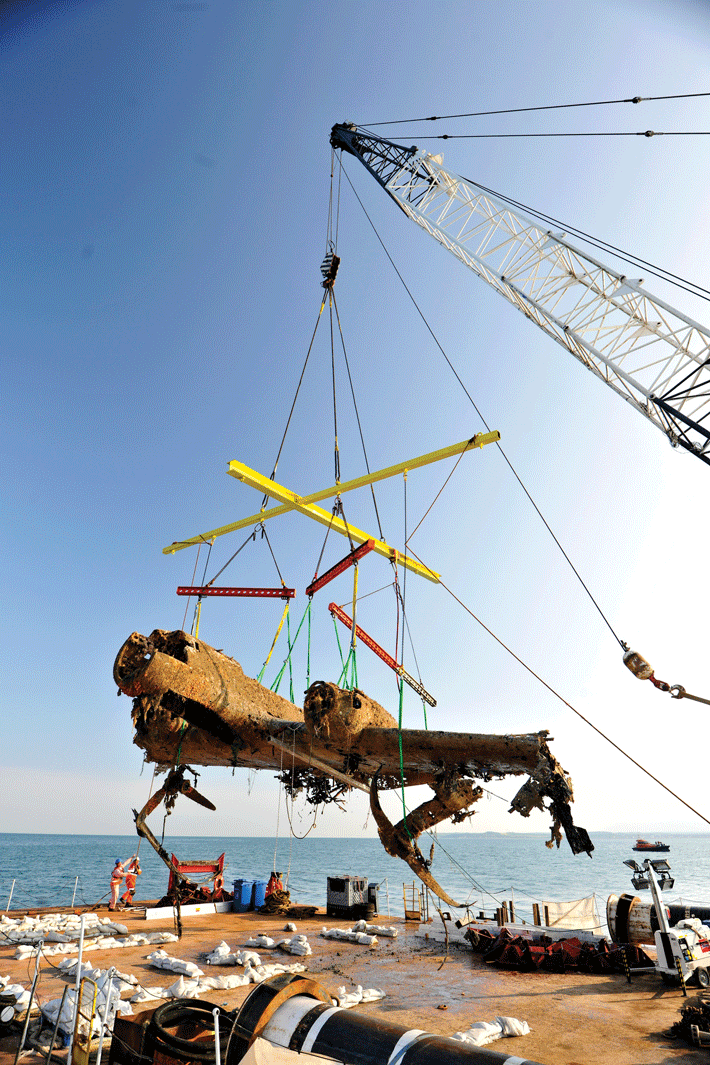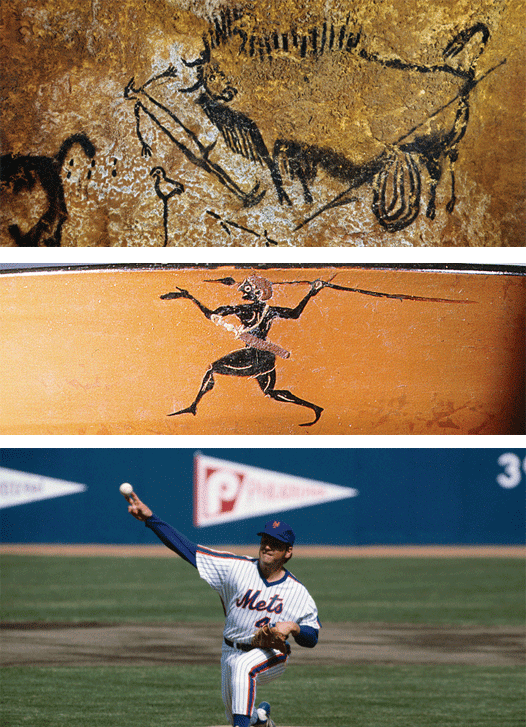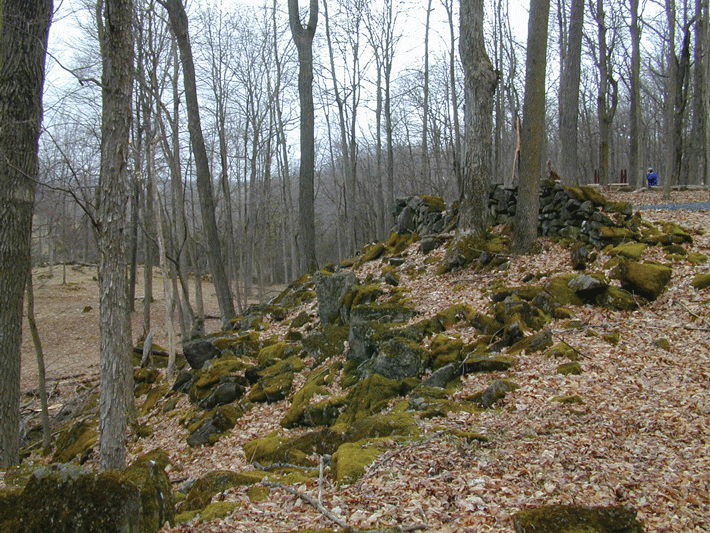From the Trenches
Small Skirmish in the War for Freedom
By MIKE TONER
Monday, August 12, 2013
 Archaeologists in Georgia have discovered the site of a Revolutionary War–era frontier fort, lost in the Southern landscape since a skirmish there on February 10, 1779, earned it a footnote in American history. Carr’s Fort, named for the cattle farmer and militia captain who owned it, was the scene of a one-day battle between 80 British loyalists and 200 local militiamen that helped blunt Britain’s efforts to retake territory in the thirteenth colony.
Archaeologists in Georgia have discovered the site of a Revolutionary War–era frontier fort, lost in the Southern landscape since a skirmish there on February 10, 1779, earned it a footnote in American history. Carr’s Fort, named for the cattle farmer and militia captain who owned it, was the scene of a one-day battle between 80 British loyalists and 200 local militiamen that helped blunt Britain’s efforts to retake territory in the thirteenth colony.
Without a precise location or description of the fort, Lamar Institute archaeologist Dan Elliott says the search was “like looking for a needle in a haystack, only harder.” Guided by historical documents, Elliott’s team combed a dozen prospective targets in a four-square-mile area of what was once Carr’s land in Wilkes County, midway between Savannah and Augusta.
On the final day of their survey they found a cluster of eighteenth-century artifacts—musket balls, parts of muskets, buttons, horseshoes, wagon parts, and a 1770 King George halfpenny—that Elliott claims marks the site of the 234-year-old fort. He says the discovery provides hope that similar ephemeral frontier fortifications (more than 30 are likely in Wilkes County alone) may be found in the future.
The Last Flying Pencil
By SAMIR S. PATEL
Monday, August 12, 2013
 More than 400 were flown by the Luftwaffe during the Battle of Britain, but today there is just one. The Royal Air Force Museum has lifted the last known intact Dornier Do 17—known as the “Flying Pencil” for its svelte profile—from the English Channel. The German bomber crashed following a dogfight in August 1940. Conservation of the plane will include spraying it continuously with a solution of citric acid for 18 to 24 months.
More than 400 were flown by the Luftwaffe during the Battle of Britain, but today there is just one. The Royal Air Force Museum has lifted the last known intact Dornier Do 17—known as the “Flying Pencil” for its svelte profile—from the English Channel. The German bomber crashed following a dogfight in August 1940. Conservation of the plane will include spraying it continuously with a solution of citric acid for 18 to 24 months.
No Changeups on the Savannah
By ZACH ZORICH
Monday, August 12, 2013
 During the several-million-year journey our ancestors made from climbing trees to living their lives primarily on the ground, they evolved two traits that would ensure that our species thrive: upright posture and the ability to hurl a 100-mile-per-hour fastball. Humans are able to throw much harder and more accurately than any of the great apes, despite having much less powerful muscles than many of them. This key adaptation may have contributed greatly to Homo sapiens’ success as hunters and, in turn, to our success as a species, according to a team of researchers led by Neil Roach of George Washington University. The team studied 20 experienced throwers to uncover the reasons for this unique ability, and to understand when it may first have evolved. The secret seems to lie in our shoulders.
During the several-million-year journey our ancestors made from climbing trees to living their lives primarily on the ground, they evolved two traits that would ensure that our species thrive: upright posture and the ability to hurl a 100-mile-per-hour fastball. Humans are able to throw much harder and more accurately than any of the great apes, despite having much less powerful muscles than many of them. This key adaptation may have contributed greatly to Homo sapiens’ success as hunters and, in turn, to our success as a species, according to a team of researchers led by Neil Roach of George Washington University. The team studied 20 experienced throwers to uncover the reasons for this unique ability, and to understand when it may first have evolved. The secret seems to lie in our shoulders.
“For the brief instant that the throw occurs, you are storing about 50 percent of the energy that you need to create this tremendous velocity in your shoulder,” says Roach, who conducted the research while at Harvard University. When the participants cocked their arms back to throw, the tendons and ligaments in their shoulders stretched and stored up energy that was then released in a burst. Roach identified three anatomical traits that humans evolved to perform this feat—torsos that move independently of our waists, shoulders located on the sides of our torsos, and upper-arm bones shaped to increase our ability to stretch the shoulder tendons and ligaments.
“I can’t think of a better design,” says Glenn Fleisig, research director of the American Sports Medicine Institute. Fleisig has spent much of his career working on shoulder injuries. “I might make the shoulder socket deeper,” he says. “That would make it harder to have a shoulder injury, but you would have less flexibility to do other tasks.” Shoulder evolution involved a similar trade-off, as hominins lost some of their ability to move easily through trees in exchange for the improved ability to throw.
When the modern shoulder first evolved is a matter of some dispute. According to Roach and coauthor Dan Lieberman of Harvard University, the traits for modern throwing came together in Homo erectus no later than 1.6 million years ago, and possibly much earlier. Susan Larson of Stony Brook University, however, reconstructs the H. erectus shoulder differently and believes that Homo heidelbergensis was the first hominin to have modern throwing ability.
Roach and Lieberman regard the evolution of the shoulder as one part of a suite of anatomical changes that helped hominins to move out of the trees to gather new foods and begin hunting. They see natural selection acting on these new behaviors and driving further evolutionary changes that made us better runners and throwers. “There is selection for the hunting and gathering way of life,” says Lieberman.
Off the Grid
By MALIN GRUNBERG BANYASZ
Monday, August 12, 2013

Starting in July 1776, American troops under General Philip Schuyler built a massive fort on Rattlesnake Hill, overlooking Lake Champlain in western Vermont. The purpose of the fort, along with the old French Fort Ticonderoga across the narrows in New York, was to prevent a British invasion from Canada. On July 28, the Declaration of Independence was read to the assembled soldiers, and the hill acquired the name it holds today: Mount Independence. In early July 1777, the British drew close. With too few American soldiers, Major General Arthur St. Clair and his officers decided to withdraw. Though there was an uproar about the loss of the forts, this decision, and a successful rearguard action at the Battle of Hubbardton, saved the American Northern Army for later victories at Bennington and Saratoga. Today, Mount Independence is a Vermont State Historic Site and one of the best-preserved Revolutionary War–era archaeological sites in America. According to Elsa Gilbertson, the regional historic site administrator, the history of the site is visible among hundreds of acres of forests and meadows.
The site
The fort at Mount Independence was a three-level defensive system that made use of the rugged topography. There were batteries, a star-shaped fort with barracks, three brigade encampments, the largest American hospital built during the Revolution, blockhouses, storehouses, wharves, and a bridge to Fort Ticonderoga. Along six miles of hiking trails, visitors can see the remains of many of these structures, as well as stunning vistas of Lake Champlain. In 1996, a museum was built there in the shape of a bateau, a flat-bottomed boat commonly used during this period, to symbolize the strategic and economic importance of Lake Champlain. Exhibits lay out the role of Mount Independence and the life of its soldiers through artifacts excavated there, including a cannon, logs from the bridge, ammunition, construction tools, buttons, cuff links, and medicine cups.
While you’re there
The town of Orwell in Addison County is full of historic buildings, including the unique First National Bank of Orwell, which has been in business at the same location since 1863. The charming bandstand on the green is perfect for a picnic. Visitors can continue on to the Hubbardton Battlefield State Historic Site to see where the Americans, British, and Germans fought after the withdrawal from the forts. And to the north is the Chimney Point State Historic Site, the location of a 1731 French fort.
Advertisement
Advertisement
IN THIS ISSUE
From the Trenches
No Changeups on the Savannah
Off the Grid
The Last Flying Pencil
Small Skirmish in the War for Freedom
Sifting Through Molehills
City of Red Stone
Animal Offerings of the Aztecs
High-Definition Obsidian
Tomb of the Wari Queens
Golden Sacrifices
Spain's Lost Jewish History
Samson and the Gate of Gaza
French Wine, Italian Vine
Neanderthal Brain Strain
Advertisement

Recent Issues
-
 May/June 2024
May/June 2024
-
 March/April 2024
March/April 2024
-
 January/February 2024
January/February 2024
-
 November/December 2023
November/December 2023
-
 September/October 2023
September/October 2023
-
 July/August 2023
July/August 2023
-
 May/June 2023
May/June 2023
-
 March/April 2023
March/April 2023
-
 January/February 2023
January/February 2023
-
 November/December 2022
November/December 2022
-
 September/October 2022
September/October 2022
-
 July/August 2022
July/August 2022
-
 May/June 2022
May/June 2022
-
 March/April 2022
March/April 2022
-
 January/February 2022
January/February 2022
-
 November/December 2021
November/December 2021
-
 September/October 2021
September/October 2021
-
 July/August 2021
July/August 2021
-
 May/June 2021
May/June 2021
-
 March/April 2021
March/April 2021
-
 January/February 2021
January/February 2021
-
 November/December 2020
November/December 2020
-
 September/October 2020
September/October 2020
-
 July/August 2020
July/August 2020
-
 May/June 2020
May/June 2020
-
 March/April 2020
March/April 2020
-
 January/February 2020
January/February 2020
-
 November/December 2019
November/December 2019
-
 September/October 2019
September/October 2019
-
 July/August 2019
July/August 2019
-
 May/June 2019
May/June 2019
-
 March/April 2019
March/April 2019
-
 January/February 2019
January/February 2019
-
 November/December 2018
November/December 2018
-
 September/October 2018
September/October 2018
-
 July/August 2018
July/August 2018
-
 May/June 2018
May/June 2018
-
 March/April 2018
March/April 2018
-
 January/February 2018
January/February 2018
-
 November/December 2017
November/December 2017
-
 September/October 2017
September/October 2017
-
 July/August 2017
July/August 2017
-
 May/June 2017
May/June 2017
-
 March/April 2017
March/April 2017
-
 January/February 2017
January/February 2017
-
 November/December 2016
November/December 2016
-
 September/October 2016
September/October 2016
-
 July/August 2016
July/August 2016
-
 May/June 2016
May/June 2016
-
 March/April 2016
March/April 2016
-
 January/February 2016
January/February 2016
-
 November/December 2015
November/December 2015
-
 September/October 2015
September/October 2015
-
 July/August 2015
July/August 2015
-
 May/June 2015
May/June 2015
-
 March/April 2015
March/April 2015
-
 January/February 2015
January/February 2015
-
 November/December 2014
November/December 2014
-
 September/October 2014
September/October 2014
-
 July/August 2014
July/August 2014
-
 May/June 2014
May/June 2014
-
 March/April 2014
March/April 2014
-
 January/February 2014
January/February 2014
-
 November/December 2013
November/December 2013
-
 September/October 2013
September/October 2013
-
 July/August 2013
July/August 2013
-
 May/June 2013
May/June 2013
-
 March/April 2013
March/April 2013
-
 January/February 2013
January/February 2013
-
 November/December 2012
November/December 2012
-
 September/October 2012
September/October 2012
-
 July/August 2012
July/August 2012
-
 May/June 2012
May/June 2012
-
 March/April 2012
March/April 2012
-
 January/February 2012
January/February 2012
-
 November/December 2011
November/December 2011
-
 September/October 2011
September/October 2011
-
 July/August 2011
July/August 2011
-
 May/June 2011
May/June 2011
-
 March/April 2011
March/April 2011
-
 January/February 2011
January/February 2011
Advertisement






